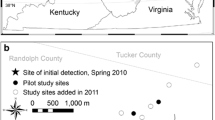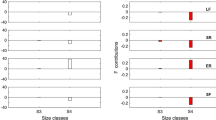Abstract
Water hyacinth, Eichhornia crassipes, is an invasive, tropical, aquatic plant that has caused significant environmental and economic damage since its establishment in Louisiana, USA, in 1884. Both invasion control programs and freezing temperatures are known to negatively affect water hyacinth populations; however, the combined impact of these factors on water hyacinth population dynamics has not yet been quantified, thereby limiting the ability to isolate the effectiveness of biocontrol and other types of control under variable weather conditions. We built a seasonal logistic population model that included time-varying intrinsic growth and overwinter mortality parameters which were estimated by fitting the model to vegetation survey data. We estimated that annual overwinter mortality rates declined from a peak of 71 % in 1977 to the time series low of 11 % in the winter of 1992, followed by an average of 28 % per year from 1993 to 2013. After accounting for the magnitude and trend of overwinter dieback events, our model predicted that the intrinsic growth rate of the Louisiana water hyacinth population declined by 84 % between 1976 and 2013. Despite higher average winter temperatures in recent decades, the population has not rebounded. Our study reveals the dramatic effectiveness of Louisiana’s biological control program to successfully suppress water hyacinth invasion.




Similar content being viewed by others
References
Bock JH (1969) Productivity of the water hyacinth Eichhornia crassipes (Mart.) Solms. Ecology 50:460–464
Burnham KP, Anderson DR (2002) Model selection and multimodel inference: a practical information-theoretic approach. Springer, New York
Center TD, Cofrancesco AF, Balciunas JK (1988) Biological control of aquatic and wetland weeds in the southeastern United States. In: Proceedings of the VII international symposium on biological of weeds, 1988, pp 239–262
Chang Y, Brodziak J, O’Malley J, Lee H, DiNardo G, Sun C (2015) Model selection and multi-model inference for Bayesian surplus production models: a case study for Pacific blue and striped marlin. Fish Res 166:129–139
Cofrancesco A, Stewart R, Sanders D (1985) Impact of Neochetina eichhorniae (Coleoptera: Curculionidae) on waterhyacinth in Louisiana. In: Delfosse ES (ed) Proceedings of the VI international symposium on biological control of weeds, 1985. Agriculture Canada, Ottawa
Deroba JJ, Schueller AM (2013) Performance of stock assessments with misspecified age-and time-varying natural mortality. Fish Res 146:27–40
Francis CR, Hurst RJ, Renwick JA (2003) Quantifying annual variation in catchability for commercial and research fishing. Fish Bull 101:293–304
Fu C, Quinn TJ II (2000) Estimability of natural mortality and other population parameters in a length-based model: Pandalus borealis in Kachemak Bay, Alaska. Can J Fish Aquat Sci 57:2420–2432
Gotelli NJ (1995) A primer of ecology. Sinauer Associates Incorporated, Sunderland
Goyer RA, Stark JD (1984) The impact of Neochetina eichhorniae on waterhyacinth in southern Louisiana. J Aquat Plant Manag 22:57–61
Holm L, Weldon L, Blackburn R (1969) Aquatic weeds. Science 166:699–709
Jiao Y, Smith EP, O’Reilly R, Orth DJ (2012) Modelling non-stationary natural mortality in catch-at-age models. ICES J Mar Sci 69:105–118
Johnson KF et al (2015) Time-varying natural mortality in fisheries stock assessment models: identifying a default approach. ICES J Mar Sci 72:137–150
Kilgen RH (1978) Growth of channel catfish and striped bass in small ponds stocked with grass carp and water hyacinths. Trans Am Fish Soc 107:176–180
Linton BC, Bence JR (2011) Catch-at-age assessment in the face of time-varying selectivity. ICES J Mar Sci 68:611–625
Madsen JD, Luu KT, Getsinger KD (1993) Allocation of biomass and carbohydrates in waterhyacinth (Eichhornia crassipes): pond-scale verification. US Army Corps of Engineers Waterways Experiment Station Vicksburg, Missouri
Manning JH (1979) Establishment of water hyacinth weevil populations in Louisiana. J Aquat Plant Manag 17:39–41
Nesslage GM, Wilberg MJ (2012) Performance of surplus production models with time-varying parameters for assessing multispecies assemblages. N Am J Fish Manag 32:1137–1145
Owens CS, Madsen JD (1995) Low temperature limits of water hyacinth. J Aquat Plant Manag 33:63–68
Penfound WT, Earle TT (1948) The biology of the water hyacinth. Ecol Monogr 18:447–472
Prager M (1994) A suite of extensions to a nonequilibrium surplus-production model. Fish Bull 92:374–389
Schirripa MJ, Goodyear CP, Methot RM (2009) Testing different methods of incorporating climate data into the assessment of US West Coast sablefish. ICES J Mar Sci 66:1605–1613
Wilberg MJ, Bence JR (2006) Performance of time-varying catchability estimators in statistical catch-at-age analysis. Can J Fish Aquat Sci 63:2275–2285
Wilberg MJ, Thorson JT, Linton BC, Berkson J (2009) Incorporating time-varying catchability into population dynamic stock assessment models. Rev Fish Sci 18:7–24
Wilson JR, Holst N, Rees M (2005) Determinants and patterns of population growth in water hyacinth. Aquat Bot 81:51–67
Acknowledgments
We thank Alexander Perret, Michael Harden, and Richard Brassette (ret.) of LDWF for providing vegetation survey data and information about Louisiana’s water hyacinth control program. We also thank Anna McMurray for assistance in compiling the data, and Michael Wilberg and Dong Liang for constructive modeling discussions. Funding was provided by the US Army Corps of Engineers Aquatic Plant Control Research Program, under management of Dr. Linda Nelson. This is contribution number 5184 of the University of Maryland Center for Environmental Science.
Author information
Authors and Affiliations
Corresponding author
Rights and permissions
About this article
Cite this article
Nesslage, G.M., Wainger, L.A., Harms, N.E. et al. Quantifying the population response of invasive water hyacinth, Eichhornia crassipes, to biological control and winter weather in Louisiana, USA. Biol Invasions 18, 2107–2115 (2016). https://doi.org/10.1007/s10530-016-1155-9
Received:
Accepted:
Published:
Issue Date:
DOI: https://doi.org/10.1007/s10530-016-1155-9




